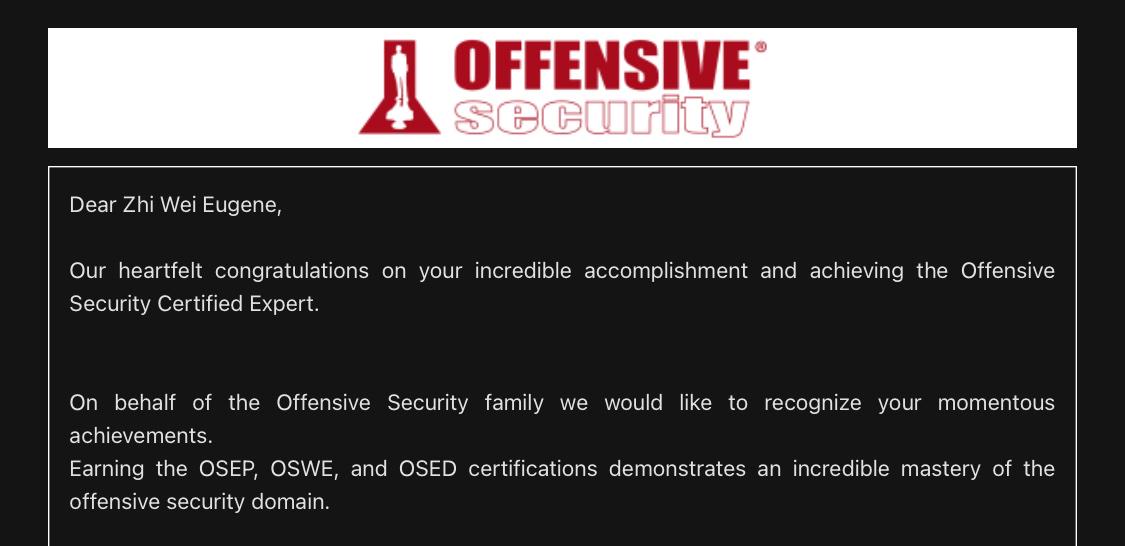The Rule of Three 🔗

The Windows User Mode Exploit Development (EXP-301) course and the accompanying Offensive Security Exploit Developer (OSED) certification is the last of the three courses to be released as part of the Offensive Security Certified Expert – Three (OSCE3) certification. Since the appointment of the new CEO Ning Wang in 2019, Offensive Security has revamped its venerable lineup of courses and certifications, culminating in the new OSCE3 announced at the end of 2020. As I’ve discussed in my Offensive Security Experienced Penetration Tester (OSEP) review, this makes a lot of sense from a marketing and sales strategy standpoint. Although Offensive Security was best known for its no-expiry certifications, it has since retired a number of them, including the old OSCE and more recently Offensive Security Wireless Attacks (OSWP). It has also introduced a number of recurring revenue subscription products such as the Offensive Security Proving Grounds, PWK365, and more. Oh, and it’s raising the price of exam retakes from $150 to $249. These are all great business decisions for Offensive Security, but for the regular cybersecurity professional, is the EXP-301/OSED worth it?
When it comes to learning exploit development, the foundations haven’t really changed since Corelan’s classic exploit writing tutorial series in 2009. You start with the basic overflows and structured exception handlers, then move on to increasingly challenging bypasses such as data execution prevention and address space layout randomisation. You learn to do return oriented programming, custom shell coding, and more intermediate topics - all in x86. That’s because even though the modern exploit development environment is incredibly different from 2009, the fundamentals have largely remained the same. However, it’s still a steep learning curve for most because you have to reconfigure your thought process around stacks and assembly code - not exactly the most intuitive concepts.
That’s why a foundational exploit development course in x86 is still relevant today and I felt that EXP-301 does this very well. You could definitely just do Corelan’s free exploit writing tutorial series, but you won’t be working on modern tools such as WinDBG and IDA. Additionally, EXP-301 provides a huge amount of material to guide you every step of the way until it finally clicks in your head. I can’t emphasize this enough - whether you are working in x86 or x64, in x64dbg or WinDBG, unless you have achieved a high level of familiarity with manipulating the stack in assembly-land, you will face endless difficulties. The labs are excellent at honing particular aspects of exploit development before the exam brings them all together in classic “Try Harder” fashion. EXP-301 shines when it taps on Offensive Security’s exploit heritage.
After clearing the OSEP at the end of February 2021, I took the 60-day EXP-301/OSED package from March to May 2021, and finally cleared the exam in mid-June. At the time of writing, this costs $1299. As my job role is pretty multi-disciplinary, I found it necessary to build up my exploit development skills and the OSED came at a right time. I also can’t deny that the lure of the OSCE3 “halo” certification pushed me to take it - the marketing is working! While I have previously done the Corelan series and the occasional exploit development tutorial, I didn’t quite grok it. In addition, while I was more comfortable in application security and penetration testing, I felt that I lacked that extra punch in my offensive skills without binary exploitation. Here’s my review along with some tips and tricks to maximise your OSED experience.
What You Should Know 🔗
Offensive Security recommends the following pre-requisites to take the Windows User Mode Exploit Development course:
- Familiarity with debuggers (ImmunityDBG, OllyDBG)
- Familiarity with basic exploitation concepts on 32-bit
- Familiarity with writing Python 3 code
The following optional skills are recommended:
- Ability to read and understand C code at a basic level
- Ability to read and understand 32-bit Assembly code at a basic level
However, while I think these pre-requisites are sufficient for the first half the course, once you move into return-oriented programming and reverse engineering, understanding 32-bit assembly code is no longer optional. You should really build up your familiarity with assembly and reverse engineering as much as possible before taking the course. In addition, you would save a lot of time in the earlier sections by completing some of the Corelan exploit writing tutorials first - EXP-301 tracks it pretty closely.
As with all Offensive Security courses, EXP-301 teaches you everything you need to know on top of the recommended pre-requisites, but unless you have the time to thoroughly study the materials on a consistent basis, you may find it difficult to fully grasp the concepts without additional preparation.
What You Will Learn 🔗
Unlike PEN-300/OSEP, which taught a broad array of topics in penetration testing, EXP-301 sticks close to the fundamentals and goes deep. As mentioned earlier, you start with the basics of buffer overflows and SEH overwrites, but the course quickly moves on to reverse engineering with IDA, custom shell coding your egg hunters and reverse shells, ROP chaining, and finally format string attacks.
I found that EXP-301 is especially strong in three areas: reverse engineering, custom shell code, and ROP. While some might question the usefulness of teaching IDA Free when Ghidra is a thing, I’d say that the two are pretty interchangeable at this level. Furthermore, IDA Pro remains the standard for advanced users, so it’s better to get acquainted with IDA first. Interestingly, by forcing you to rely on IDA Free’s limited set of features, the course makes you better at reverse engineering in the long run. While I considered myself fairly proficient at the basics of reverse engineering, having completed two-thirds of last year’s Flare-On challenges, I still relied on bad analysis patterns and leaned hard on the pseudocode crutch. With only assembly decompilation and limited signatures in IDA Free, I could no longer do that.
ROP chaining and custom shell coding can be incredibly hard to master because it’s difficult for most people to intuitively understand these concepts. Before the course, while I knew the basic principles of ROP, I could hardly get started. EXP-301 properly explains every step of the process, working through each assembly instruction over multiple exercises until it flows naturally for you. By the middle of the course, I was comfortable enough to apply ROP to my own vulnerability research and successfully built exploits for real-world bugs that are now pending full disclosure.
However, the two format string attacks chapters were a little weak. Placed at the end of the course, they cover format string reads and writes respectively. While the concepts are taught well, I could definitely have used a bit more practice in exploiting them. Perhaps the course could have taught more attack vectors and format string variants.
Overall, each chapter builds well on the previous one, creating a solid foundation for exploit development.
What You Should Also Learn By Yourself 🔗
As an exploit development rather than a vulnerability research course, EXP-301 only covers the reverse engineering route to finding bugs. You won’t learn fuzzing or source code review which can be entire courses in themselves. You may want to learn these in order to properly conduct vulnerability research on your own. You can check out my Peach Fuzzer tutorial for a beginner’s quickstart to fuzzing - there are plenty of write-ups and tutorials out there. One big difference between EXP-301 and the Corelan tutorials is that the former only deals with network-based exploits, while some of the exploits covered by Corelan are file-based. This is another huge domain to cover.
Other than that, the obvious next steps would be the concepts covered by the Advanced Windows Exploitation course: kernel exploits, type confusion, heap spraying and more - approaching real mastery. You wouldn’t really expect these in a foundational exploit development course, but they are necessary to go far.
How I Prepared for the Exam 🔗
To prepare for the exam, I tried to complete all the exercises and extra miles, missing out only two super-hard ones (you will know what they are; the course tells you as much). I also completed all of the lab machines.
Additionally, I worked on building my automation. Epi has a fantastic OSED-scripts repo that automates various tasks in exploit development, such as categorising ROP gadgets and generating building blocks for custom shell code. However, if you use them without understanding them, it’s a recipe for disaster - focus on understanding how and why these scripts work by reading the code and stepping through various exercises with them. I contributed my own additions and edits to the repo as I practised, which helped me better understand the underlying concepts. You could do what I did and modify the repo or write your own automation, but the end goal should be solidifying your fundamentals, not taking short cuts.
Other than that, I also applied some of the course knowledge in my own vulnerability research. As mentioned earlier, these vulnerabilities are pending full disclosure but I’m pretty excited about them because they demonstrated an immediate application of the skills I learned in the course.
I also highly recommend joining the official Offensive Security Discord server. You get to chat with other students and Offensive Security staff as you work through the course, which really helps to clear up misunderstandings or clarify concepts. Big shoutout to @TheCyberBebop @epi @bonjoo @hdtran and more!
I was very apprehensive about the exam, and I was right to be. While the OSWE and OSEP exams were generally in line with what I expected based on the courses and labs, the OSED exam was a whole other beast. It was kind of like looking at everything I had been taught in the course through a funhouse mirror - same same but different. Try Harder different. At every turn, I felt like obstacles had been specifically placed in my way to make things more difficult. I advise you to read the instructions properly and manage your time well. By the end of the exam, I had completed all of the three challenges, although one of them only worked on the development machine. I realised why only when writing my report - a real facepalm moment! Let’s just say I didn’t sleep much during that 48-hour exam.
I submitted my report on Wednesday and received the exciting news that I had passed the following Tuesday afternoon. I also received a second congratulatory message that I had achieved the OSCE3.

Triple Threat 🔗
To answer the question, “Is EXP-301 worth it?” you can think about it in two ways. As a foundational exploit development course, I think it’s fantastic. It really gets you to a level of familiarity with the fundamentals such as reading assembly code and manipulating the stack that is hard to achieve with free write-ups. As part of the OSCE3, I think it is a nice testament to your all-round skill and ability to withstand suffering, but not strictly necessary. While offensive security roles tend to be fairly inter-disciplinary, it is also perfectly possible to stay within the application security or penetration testing domains without ever needing to read a line of assembly code. Only take this on if you’re sure you need the exploit development skills or if you have the resources to splash out on completing the trilogy for the sake of it.
As to what’s next, Offensive Security continues to refresh its product line under the new direction of the CEO. It recently announced that the Wireless Attacks course would be retired, possibly paving the way for a modern Internet-Of-Things course. At its current price-to-value ratio, Offensive Security sits in between the mass-market Udemy-style courses and the sky-high SANS and bespoke trainings. Personally, I’m interested to see how it’ll shake up this market in the long run.